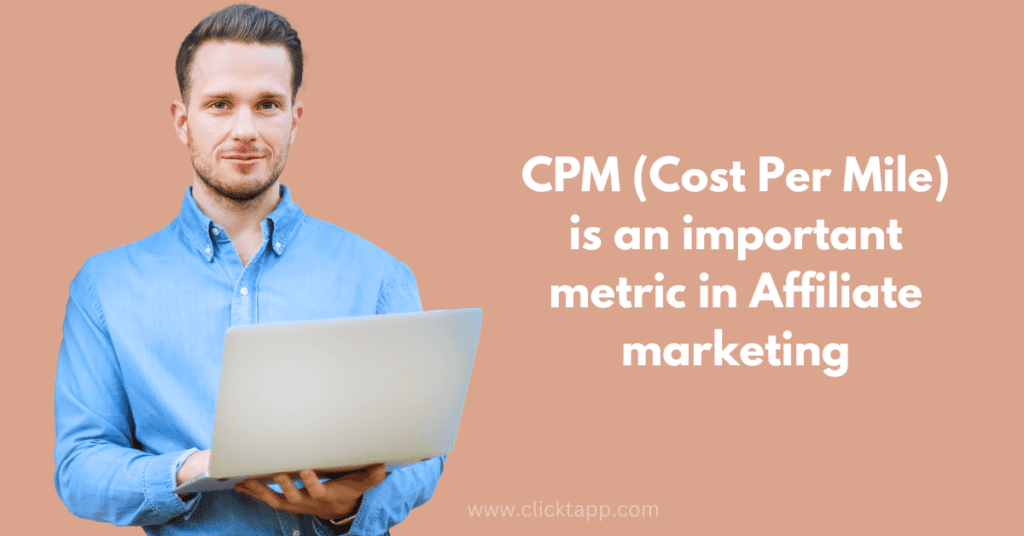CPM (Cost Per Mile) in 2024: Affiliate and Performance Marketing Uses
CPM (Cost Per Mile) is an important metric in digital marketing. It helps advertisers, affiliates, and platforms understand the value of their ads. In 2024, it’s crucial to understand CPM’s details in affiliate and performance marketing. This analysis looks at why CPM is important, how to use it, and what it means for the future.

Understanding CPM (Cost Per Mile) in Affiliate and Performance Marketing
CPM, or cost per thousand impressions, is a crucial metric in the advertising world. It calculates the cost of displaying an ad to a thousand people. This makes it different from CPC (cost per click) and CPA (cost per acquisition). They focus on actions taken after viewing the ad. To illustrate, imagine a billboard on a busy highway. With CPM, you pay for the number of people who see the ad. You need to pay for how many stops to buy the product or visit the website. This approach helps advertisers gauge their campaigns’ reach, not the response. For instance, a company might use CPM to promote a new product launch. Regardless of the conversion rate, they want to get their brand in front of as many people as possible.
The Role of CPM (Cost Per Mile) in 2024’s Marketing Landscape
Traditional advertising methods and advanced technologies merge in the 2024 digital marketing environment. In this context, CPM remains relevant for several reasons:
1. CPM is a valuable metric for brand visibility campaigns. It’s valuable even without immediate conversions. It allows advertisers to measure the reach of their message.
2. CPM offers a predictable pricing model. Advertisers can manage their budgets, especially when targeting high-traffic websites or platforms.
3. Performance Benchmarking allows advertisers to compare CPM rates across different channels. This helps them assess the relative value and performance of their marketing efforts. They can then optimize strategies for better ROI.

Strategic Uses of CPM in Affiliate Marketing
Advertisers and affiliates in affiliate marketing can use CPM to benefit through partnerships:
1. Publishers or affiliates with high-traffic websites can monetize their content through CPM advertising. This provides them with a steady revenue stream based on their site’s viewership.
2. Affiliates can use CPM data to make informed decisions. They can choose the best types of content or platforms that yield the best returns. This way, they focus their efforts on those areas to maximize earnings.
3. Affiliates can analyze CPM across various channels. This helps them craft a multi-channel marketing strategy. The strategy optimizes visibility and engagement, increasing the potential for higher conversions.

CPM in Performance Marketing: A Deep Dive
Performance marketing focuses on tangible results, such as clicks, conversions, and sales. Within this realm, CPM serves many purposes:
1. Marketers can use CPM-based campaigns for market testing and gaining insights. They can do this before investing in more expensive CPC or CPA campaigns. This helps them understand audience behavior and preferences better.
2. CPM campaigns can complement CPA or CPC models. They build awareness, which increases conversion rates and lowers the cost per acquisition.
3. For remarketing efforts, CPM allows brands to stay in front of bounced traffic cheaply. This keeps the brand at the top of the consumer’s mind when they are ready to make a purchase.
Future Potential of CPM
As we look ahead, the potential of CPM continues to evolve. It’s evolving in affiliate and performance marketing. It’s changing with technological advancements and market trends:
1. Algorithms predict user reactions to ads. Then, they adjust messages for better impact. AI fine-tunes these ads in real-time. Marketers use this tech to target audiences. This makes campaigns more efficient.
2. Programmatic advertising platforms are on the rise. They aim to make CPM campaigns more efficient and targeted. These platforms automate the buying and selling of ads. They enable precise targeting and real-time bidding. This can lead to lower CPM rates.
3. Advertisers will be able to track and report impressions more. This will happen through transparency and fraud prevention. This is due to a growing emphasis on transparency and blockchain technology. This will reduce ad fraud risk and ensure more reliable CPM metrics.
4. Standards for measurement are changing. They now emphasize viewable and engaged impressions. This shift makes CPM more valuable and accurate for advertisers and affiliates. As a result, they will get better insights into ad performance.

Conclusion
In 2024, CPM remains an important measure in affiliate and performance marketing. Brands enjoy seeing themselves, managing budgets, and comparing performance. New technology will make it even better. It will be more accurate and more valuable in digital marketing campaigns. As the digital world changes, advertisers and affiliates need to use CPM. It will shape the future of digital advertising. Marketers should stay up to date with these trends and adjust their strategies. By using CPM, marketers can succeed in the digital world and achieve their goals.
Here are some important FAQs about Cost Per Mile(CPM) in affiliate marketing
What is the Cost Per Mile (CPM) in affiliate marketing?
In affiliate marketing, CPM stands for “Cost Per Mille,” where “mille” means thousand. It is the cost an advertiser pays for every thousand ad views.
How is CPM calculated in affiliate marketing?
To find CPM, divide the total cost of the ad campaign by the total number of impressions. Then, multiply by 1,000. The formula is:
CPM = Total Impressions / Total Ad Spend × 1,000
Why is CPM important in affiliate marketing?
CPM is crucial. It helps advertisers measure their campaigns’ ROI in visibility and brand awareness. It allows them to budget and plan their advertising spending more effectively.
What factors influence CPM rates in affiliate marketing?
Factors include the ad’s quality and relevance, the target audience, and the platform. Also, the audience’s location and the time of year matter.
What is a good CPM rate in affiliate marketing?
A good CPM rate can vary widely depending on the industry and target audience. Generally, lower CPM rates are better as they show more cost-effective advertising. Typical CPM rates can range from $1 to $10 or more.
How does CPM differ from other pricing models, like CPC or CPA?
Unlike CPC and CPA, CPM charges for impressions, not clicks. This model focuses on visibility rather than direct user actions.
What are the advantages of using CPM in affiliate marketing?
CPM is beneficial for brand awareness campaigns where the goal is to reach a large audience. It gets the ad seen by many. This can boost brand recognition and future sales.
What are some best practices for optimizing CPM campaigns?
Best practices include targeting the right audience. Use high-quality, engaging ads. Test different ad formats. Adjust the campaign based on performance data.
How can affiliates maximize their earnings with CPM?
Affiliates can boost earnings by driving high traffic to their sites. They should engage their audience and place ads in visible spots. They should also work with reputable ad networks that offer competitive CPM rates.
What are some common challenges with CPM in affiliate marketing?
Common challenges include ad fatigue, ensuring ads are relevant, and tracking impressions. Ad fatigue is when users become desensitized to ads. Additionally, high competition can drive up CPM rates.



Pingback: CPL(Cost Per Lead) in 2024: What to Expect in 2024 - Clicktapp
Pingback: CPM (Cost Per Mile) Advertising: Maximizing Reach and ROI -